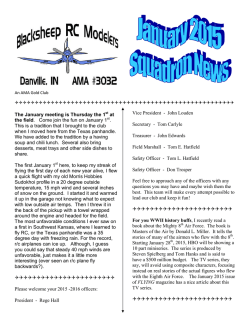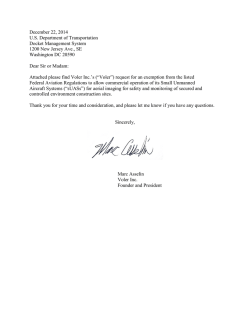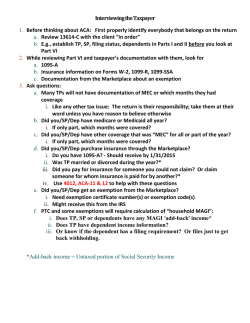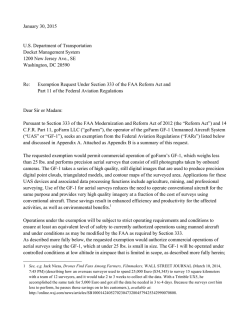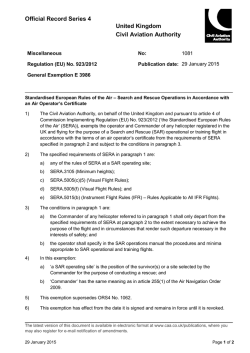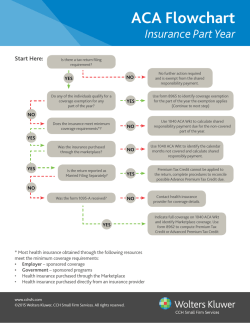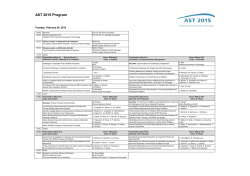
January 19, 2014 U.S. Department of Transportation Docket
Albany Northern Virginia Atlanta Orange County Brussels Rancho Santa Fe 1676 International Drive • Penthouse McLean, VA 22102 Tel: 703.336.8800 mckennalong.com Denver Los Angeles San Diego San Francisco Miami Seoul New York Washington, DC MARK E. MCKINNON 703.336.8708 EMAIL ADDRESS [email protected] January 19, 2014 U.S. Department of Transportation Docket Management System 1200 New Jersey Ave., SE Washington, DC 20590 Re: Petition of Contend Corp. for an Exemption Pursuant to Section 333 of the FAA Modernization and Reform Act of 2012 To Whom it May Concern: Pursuant to Section 333 of the FAA Modernization and Reform Act of 2012 ("Reform Act") and 14 C.F.R. Part 11, Contend Corp. ("Contend") hereby applies for an exemption from the Federal Aviation Regulations ("FARs") identified below, to allow commercial filming, cinematography and videography using small unmanned aerial vehicles (i.e., "small unmanned aircraft" or "UAS"). This petition for exemption is made based on information outlined in this Petition for Exemption, as well as the accompanying Contend's UAS Operations Manual (hereinafter "Contend's Ops Manual") and S900 User Manual (hereinafter "S900 Manual")1. Contend submits these supporting materials as confidential documents pursuant to 14 C.F.R. § 11.35(b), as the materials contain confidential commercial and/or proprietary information that Contend has not and will not share with others. Additionally, these documents contain operating conditions and procedures that are not generally available to the public and are protected from release under the Freedom of Information Act, 5 U.S.C. § 552 et seq., and any other requirements established by the FAA pursuant to Section 333 of the Reform Act. 1 The term "S900 Manual" includes all relevant manufacturer publications, including, but not limited to: operations and flight manuals, user guides, component maintenance manuals, pilot training manuals, service information letters and, safety/service bulletins. U.S. Department of Transportation January 19, 2014 Page 2 For your convenience, this Petition is organized as follows: I. II. III. IV. Description of Petitioner Description of Proposed Operations Relevant Statutory Authority Contend's Proposed UAS Operations Meet the Requirements of Section 333 of the Reform Act A. Approval is Warranted Based on the UAS's Size, Weight, Speed, and Operational Capability B. Approval is Warranted Based on the Operational Restrictions Set Forth in the Ops Manual V. Regulations From Which Exemption is Requested A. 14 C.F.R. Part 21, Subpart H – Airworthiness Certificates and 14 C.F.R. § 91.203 B. 14 C.F.R. Part 27 Airworthiness Standards: Normal Category Rotorcraft C. 14 C.F.R. § 91.7(a): Civil Aircraft Airworthiness D. 14 C.F.R. § 91.9(b)(2): Civil Aircraft Flight Manual in the Aircraft and 14 C.F.R. § 91.203(a) and (b): Carrying Civil Aircraft Certification and Registration E. 14 C.F.R. §§ 91.9(c), 45.23(b) and 45.27(a): Aircraft Marking and Identification Requirements F. 14 C.F.R. § 91.103: Preflight Action G. 14 C.F.R. § 91.109(a): Flight Instruction H. 14 C.F.R. § 91.119: Minimum Safe Altitudes I. 14 C.F.R. § 91.121: Altimeter Settings J. 14 C.F.R. § 91.151(a): Fuel Requirements for Flight in VFR Conditions K. 14 C.F.R. § 91.405(a), 91.407(a)(1), 91.409(a)(1) and (2); 91.417(a) and (b): Maintenance Inspections L. 14 C.F.R. Part 61, 14 C.F.R. § 61.3, 14 C.F.R. § 61.113: Private Pilot Privileges and Limitations VI. Drug and Alcohol Program VII. Public Interest VIII. Privacy IX. Federal Register Summary X. Conclusion U.S. Department of Transportation January 19, 2014 Page 3 I. DESCRIPTION OF PETITIONER Contend is an innovative film production company with a proven track record of delivering cutting edge content. Contend covers the entire scope of film production, strategy, and development through writing and physical production. The company is headquartered in Los Angeles, California with an additional office in Chicago, Illinois. Contend produces content in diverse formats, from short-form web-series to feature documentaries, to scripted and unscripted TV shows. Contend employs award winning produces, directors, and writers and specialists for a multi-disciplinary approach to its projects. Contend seeks to bring this same dedication and commitment to excellence to all aspects of its air operations. The contact information for Petitioner is as follows: Philip Alberstat Chief Operating Officer, Contend LLC 23801 Calabasas Road, Suite 2026 Calabasas CA, 91302 [email protected] Telephone- (310) 770-6814 II. DESCRIPTION OF PROPOSED OPERATION Contend intends to use the DJI Spreading Wings S900 small UAS for film and cinematography work. Contend has tailored its operations to meet the requirements established by the FAA in its Grant of Exemption to Astreaus Aerial, Reg. Docket No. FAA-2014-0352. The proposed UAS operations will be conducted in accordance with the conditions and limitations of this Petition for Exemption, Contend's Operations Manual, and the DJI S900 User Manual. Contend's filming operations will be conducted in a controlled area, away from spectators and persons not involved in the filming. In addition, the filming will be conducted during daylight, VFR conditions, at altitudes below 400' AGL. As set forth below, Contend's operations provide an equivalent level of safety that is superior to performing the same work using fixed wing aircraft or helicopters. III. RELEVANT STATUTORY AUTHORITY This Petition for Exemption is submitted pursuant to Section 333(a) through (c) of the FAA Modernization and Reform Act of 2012 ("Reform Act"). Congress has directed the FAA "to safely accelerate the integration of civil unmanned aircraft systems into the national airspace U.S. Department of Transportation January 19, 2014 Page 4 system." Pursuant to Section 333 of the Reform Act, the FAA Administrator is to permit unmanned aircraft systems to operate in the National Air Space ("NAS") where it is safe to do so based on the following considerations: ● The UAS's size, weight, speed and operational capability; ● Operation of the UAS in close proximity to airports and populated areas; and ● Operation of the UAS within the visual line of sight of the operator. Additionally, the FAA Administrator has general authority to grant exemptions from the agency's safety regulations and minimum standards when the Administrator decides a requested exemption is in the public interest. See 49 U.S.C. § 106(f) (defining the authority of the Administrator); 49 U.S.C. § 44701(f) (permitting exemptions from §§ 44701(a), (b) and §§ 44702 – 44716, et seq.). A party requesting an exemption must explain the reasons why the exemption: (1) would benefit the public as a whole, and (2) would not adversely affect safety (or how it would provide a level of safety at least equal to the existing rules). See 14 C.F.R. § 11.81 (petitions for exemption). IV. CONTEND'S PROPOSED UAS OPERATIONS MEET THE REQUIREMENTS OF _ SECTION 333 OF THE REFORM ACT The small UAS operations proposed by Contend in this Petition for Exemption qualify for expedited approval pursuant to Section 333 of the Reform Act as each of the statutory criteria and relevant factors are satisfied. A. Approval is Warranted Based on the UAS's Size, Weight, Speed, and Operational Capability A Grant of Exemption is appropriate for operations conducted using the DJI S900 due to its size weight, speed, and operational capability. ● The S900 weighs less than 8 pounds, and has a maximum take-off weight of less than 18 pounds. ● The UA will not be flown at a speed in excess of 30 miles per hour; ● The UA will not be flown at an altitude that exceeds 400 feet AGL; ● All flights will be flown in such a way that they can be safely terminated with a reserve battery power of 20% of the battery's maximum charge; U.S. Department of Transportation January 19, 2014 Page 5 ● Altitude information will be generated by equipment onboard the UA as specified using GPS triangulation, digitally encoded barometric altimeter, radio altimeter, or any combination thereof. This information will be transmitted to the pilot via telemetric data feed. ● The UAS will have system redundancies and independent functionality to ensure the overall safety and predictability of the system. If connection to the remote control or ground control station is lost, failsafe systems will permit the UAS to return to a predetermined location and safely land without injury or damage. ● The radio frequencies used for operations and control of the UAS will comply with the Federal Communications Commission ("FCC") or other appropriate government oversight agency requirements. If the same operations were conducted using a helicopter, the aircraft's take-off weight would likely exceed 6,000 pounds. The difference in weight between the S900 and a helicopter significantly reduces the potential harm to the participating and non-participating individuals or property in the event of an accident or incident. In addition, the risk to the onboard pilot and camera operator is eliminated. While the motion picture industry has a strong safety history, there have been a number of notable tragedies resulting from aerial filming which could have been avoided if UAS technology had been available. See NTSB Report AAR-84-14 (three persons killed and six injured during filming on a closed set using a helicopter). B. Approval is Warranted Based on the Operational Restrictions Set Forth in the Ops Manual The Contend's Ops Manual and S900 Manual for the selected UAS will contain all the procedures and limitations necessary to safely and successfully perform the operations specified in this Petition for Exemption. To assist the FAA in making a safety assessment of Contend's proposed operations, below is a summary of operational limitations and conditions that will ensure an equivalent or higher level of safety to operations conducted under current regulatory guidelines: 1. The UAS weighs less than 18 pounds, fully loaded. 2. Minimum crew for each operation will consist of a pilot, who will be Pilot-in Command ("PIC") of the UAS, and one or more Visual Observers ("Observer") as necessary to safely conduct the mission. U.S. Department of Transportation January 19, 2014 Page 6 3. The UAS shall be operated within Visual Line of Sight ("VLOS") of the PIC and Observer at all times. The PIC must use human vision unaided by any device other than corrective lenses. 4. The Observer designated for any operation will be in constant voice contact with the PIC. 5. The additional requirements identified in the exemption grant shall be added to the Contend's Ops Manual. The Ops Manual will be maintained and made available to the Administrator upon request. If a discrepancy exists between the conditions and limitations in the granted exemptions and the Contend's Ops Manual, the conditions and limitations in the granted exemptions shall take precedence and must be followed. Otherwise, Contend's must follow the procedures outlined in their Ops Manual. 6. Maximum total flight time for each operational flight will be limited to the amount of time the UAS can be flown and still maintain a reserve battery power of no less than 20%. 7. Flights will be operated at an altitude of no more than 400 feet AGL and will never enter navigable controlled airspace without prior written authorization and approval from the FAA. 8. Lateral distances from participating persons, as defined in Order 8900.1 V3, C8, S1, will be maintained in accordance with the provisions of that Chapter. 9. Flights will be operated at a lateral distance of at least 500 feet from any nonparticipating persons, unless that person is in a position where he or she is shielded from the UAS and any possible debris resulting from UAS failure. Flight will be terminated if a nonparticipating person within 500 feet of the UAS leaves a shielded position. At no time will the UAS be conducted so close to persons or objects to present an undue hazard to the PIC or Observer, per § 91.119(a). 10. Flights will be limited to a speed of 30 miles per hour. 11. Prior to each flight the PIC shall inspect the UAS to confirm that it is in a condition safe for flight. The PIC shall not operate the UAS if the inspection reveals a condition that affects the safe operation of the UAS until the necessary maintenance has been performed and the UAS is found to be in a condition for safe flight. The Ground Control Station ("GCS") shall be included in the preflight U.S. Department of Transportation January 19, 2014 Page 7 inspection. All maintenance and alternations must be properly documented in the UAS records. 12. Any UAS that has undergone maintenance or alterations that affect the UAS operation or flight characteristics (e.g., replacement of a flight critical component) must undergo a functional test flight in accordance with Contend's Ops Manual. The PIC who conducts the functional test flight must make an entry in the UAS aircraft records of the flight. The requirements and procedures for a functional test flight and UAS record entry shall be included in the Contend's Ops Manual. 13. The UAS will be operated and maintained according to the Manufacturer's Manuals and any required manufacturer Safety/Service Bulletins. 14. Prior to the operation, there will be a Mission Plan setting forth the operational limitations and conditions for the mission, as well as key personnel contact information and a description of any potential hazards on or in the vicinity of the survey site. 15. Contend will obtain an Air Traffic Organization ("ATO") issued Certificate of Waiver or Authorization, otherwise known as a COA, prior to conducting any operations under this grant of exemption. This COA will require Contend to request a Notice to Airman ("NOTAM") with an appropriate ATC facility between 48 and 72 hours before the flight. 16. All required permissions and permits will be obtained from territorial, state, county or city jurisdictions, including local law enforcement, fire or other appropriate governmental agencies. 17. Contend will coordinate its operations with the applicable Flight Standards District Office ("FSDO"). This requirement may be waived or modified by agreement with the applicable FSDO. 18. If the UAS loses communication with the pilot, it will have the capability to return to a pre-determined location within the operational area and land safely. 19. Contingency plans will be in place to safely terminate flight if there is a loss of communication between the PIC and the Observer. 20. The UAS will have the capability to safely abort flight in the case of unpredicted obstacles or emergencies. 21. PICs and Observers will have at least a current Class III Medical Certificate. U.S. Department of Transportation January 19, 2014 Page 8 V. 22. Prior to conducting operations for filming, the PIC will have accumulated and logged, in a manner consistent with 14 CFR § 61.51(b), a minimum of 200 flight cycles and 25 hours total time as a UAS rotorcraft pilot and at least 10 hours logged as a UAS pilot with a similar UAS type. 23. Prior to conducting operations for filming, the PIC will have accumulated and logged, in a manner consistent with 14 CFR § 61.51(b), a minimum of 5 hours as UAS pilot operating the make and model of UAS to be utilized for operations under the exemption and three take-offs and three landing in the preceding 90 days. 24. Operations shall occur during daytime VFR Meteorological Conditions; flights under special visual flight rules ("SVFR") shall not be conducted. 25. The UA shall remain clear and yield the right of way to all other manned operations and activities at all times (including, but not limited to, ultralight vehicles, parachute activities, parasailing activities, hang gliders, etc.). 26. UAS Operations under Instrument Flight Rules, at night, or beyond VLOS are prohibited. REGULATIONS FROM WHICH EXEMPTION IS REQUESTED The Federal Aviation Act expressly grants the FAA the authority to issue exemptions. This statutory authority, by its terms, includes exempting civil aircraft, as the term is defined under § 40101 of the Act, including UASs, from its safety regulations and minimum standards when the Administrator decides a requested exemption is in the public interest.2 Contend seeks an exemption from several interrelated provisions of Title 14 of the Code of Federal Regulations ("14 C.F.R") Parts 21, 45, 61 and 91 for purposes of conducting the requested operations using a UAS. Listed below are: 1) the specific sections of 14 C.F.R for which exemption is sought, and 2) the operating procedures and safeguards that Petitioner has established which will ensure a level of safety better than or equal to the rules from which exemption is sought.3 2 See 49 U.S.C. § 44701(f) (authorizing the grant of exemptions from requirements of regulations prescribed pursuant to Sections 44701(a) and (b) and Sections 44702 - 44716). 3 See 14 C.F.R § 11.81(e), which requires a petition for exemption to include: {footnote continued} U.S. Department of Transportation January 19, 2014 Page 9 A. 14 C.F.R. Part 21, Subpart H – Airworthiness Certificates and 14 C.F.R. § 91.203(a)(1) The FAA has stated that no exemption is needed from this section if a finding is made under the Reform Act that the UAS selected provides an equivalent level of safety when compared to aircraft normally used for the same application. These criteria are met, and therefore no exemption is needed. See Grant of Exemption to Astraeus Aerial, Docket No. FAA2014-0352 at 13-14, 22. If, however, the FAA determines that there are some characteristics of the chosen UAS that fail to meet the requirements of the Reform Act, an exemption is requested. Equivalent Level of Safety The Contend’s use of the S900 is safe when taking into account its size, weight, speed, and operational capability. As set forth in the description of proposed operations in Section II, the UAS weighs less than 18 pounds and will be flown at less than 30 miles per hour and completely outside controlled airspace. Additionally, the S900 carries neither pilots nor passengers, carries no explosive materials or flammable liquid fuels, and operates exclusively within the parameters stated in the Ops Manual. Operations conducted under this exemption will be closely controlled and monitored by the operator and will be conducted in compliance with local public safety requirements, to provide security for the area of operation. Contend will also provide the FAA with advance notice of all operations via NOTAMs and coordination with the local FSDO, as necessary. In all cases, operation of the S900 under the proposed conditions will be at least as safe as, or safer than, conventional rotorcraft operating with an airworthiness certificate. Further, the UAS does not need a means to communicate with other aircraft or ATC, because those capabilities will be possessed by the PIC and Observer, who are not onboard the UAS. See Grant of Exemption, Docket FAA-2014-0352 at 13. In addition, no sense-and-avoid technology is necessary for the UAS because it will be operated at all times in VFR conditions and within VLOS of the PIC and Operator. See id. B. 14 C.F.R. Part 27 Airworthiness Standards: Normal Category Rotorcraft {continued from previous page} The reasons why granting the exemption would not adversely affect safety, or how the exemption would provide a level of safety at least equal to that provided by the rule from which you seek exemption. U.S. Department of Transportation January 19, 2014 Page 10 Title 14 C.F.R. Part 27 sets forth the procedural requirements for airworthiness certification of normal category rotorcraft. To the extent that Contend's small UASs would otherwise require certification under Part 27, Petitioner seeks an exemption from Part 27's airworthiness standards for the same reasons identified in the request for exemption from 14 C.F.R. Part 21, Subpart H, supra. C. 14 C.F.R. § 91.7(a): Civil Aircraft Airworthiness Inasmuch as there will be no airworthiness certificate issued for the UAS, Contend seeks an exemption from 14 C.F.R. § 91.7(a), which requires that a civil aircraft be in airworthy condition to be operated. The FAA has stated that no exemption is required for 14 C.F.R. § 91.7(a) to the extent that the requirements of Part 21 are waived or found inapplicable. See Grant of Exemption to Astraeus Aerial, Docket No. FAA-2014-0352 at 13-14, 22. Accordingly, Petitioner requests that the requirements for § 91.7(a) be treated in accordance with Section V(A), supra. D. 14 C.F.R. § 91.9(b)(2): Civil Aircraft Flight Manual in the Aircraft and 14 C.F.R. § 91.203(a) and (b): Carrying Civil Aircraft Certification and Registration Title 14 C.F.R. § 91.9(b)(2) and § 91.203(a) and (b) require the operator to carry airworthiness documents and other aircraft manuals onboard the aircraft. Pursuant to 14 C.F.R. § 91.9(b)(2): (b) No person may operate a U.S.-registered civil aircraft – … (2) For which an Airplane or Rotorcraft Flight Manual is required by § 21.5 of this chapter, unless there is available in the aircraft a current approved Airplane or Rotorcraft Flight Manual, approved manual material, markings, and placards, or any combination thereof. Pursuant to 14 C.F.R. § 91.203(a) and (b): (a) Except as provided in § 91.715, no person may operate a civil aircraft unless it has within it the following: (1) An appropriate and current airworthiness certificate… (b) No person may operate a civil aircraft unless the airworthiness certificate required by paragraph (a) of this section or a special flight authorization issued under § 91.715 is displayed at the cabin or cockpit entrance so that it is legible to passengers or crew. U.S. Department of Transportation January 19, 2014 Page 11 Given the small size and configuration of the UAS, it would be impossible to keep airworthiness documents and other aircraft manuals on board the UAS because there is simply no room and the UAS has no cabin or cockpit. Equivalent Level of Safety In an FAA Office of Chief Counsel's Opinion dated August 8, 2014, and prepared by Dean E. Griffith, Attorney, AGC-220, it was acknowledged that the intent of 14 C.F.R. 91.9(b) and 91.203(a) and (b) is met if the pilot of the unmanned aircraft has access to the UAS flight manual, registration certificate, and other required documents from the ground control station from which he or she is operating the aircraft.4 As this FAA Office of Chief Counsel Opinion clarifies, the intent of the rule is to ensure the pilot has access to these key documents during flight. Therefore, an equivalent level of safety will be achieved by ensuring that the pilot has access to the documents at the ground control station from which he or she is piloting the UAS. E. 14 C.F.R. §§ 91.9(c), 45.23(b) and 45.27(a): Aircraft Marking and Identification Requirements Contend seeks an exemption from the aircraft marking and identification requirements contained in 14 C.F.R. §§ 91.9(c), 45.23(b) and 45.27(a). ● 14 C.F.R. § 91.9(c), Civil Aircraft Flight Manual, Marking and Placard requirements, provides that: No person may operate a U.S.-registered civil aircraft unless that aircraft is identified in accordance with Part 45 of this chapter. ● 14 C.F.R. § 45.23(b), Markings of the Aircraft, states: When marks include only the Roman capital letter "N" and the registration number is displayed on limited, restricted or light-sport category aircraft or experimental or provisionally certificated aircraft, the operator must also display on that aircraft near each entrance to the cabin, cockpit, or pilot station, in letters not less than 2 inches nor more than 6 inches high, the words "limited," "restricted," "light-sport, "experimental," or "provisional," as applicable. 4 Memorandum from Mark Bury, FAA Assistant Chief Counsel for International Law, Legislation and Regulation, to John Duncan, FAA Flight Standards Service (Aug. 8, 2014); see also Docket No. FAA-2014-0352 at 16-18. U.S. Department of Transportation January 19, 2014 Page 12 ● 14 C.F.R. § 45.27(a), Rotorcraft, states: Each operator of a rotorcraft must display on that rotorcraft horizontally on both surfaces of the cabin, fuselage, boom, or tail the marks required by § 45.23. In a previous Grant of Exemption, the FAA determined that exemption from these requirements was warranted provided that the aircraft "have identification (N-Number) markings in accordance with 14 C.F.R Part 45, Subpart C if the markings are as large as practicable." FAA Docket No. FAA-2014-0352. Equivalent Level of Safety All UA flown by Contend will bear N-number markings that are as large as practicable in accordance with 14 C.F.R. Part 45, Subpart C.5 F. 14 C.F.R. § 91.103: Preflight Action Contend seeks an exemption from 14 C.F.R. § 91.103, which requires a PIC to become familiar with specific information before each flight, including information contained in the FAA-approved Flight Manual on board the aircraft. While the PIC will be familiar with all information necessary to safely conduct the flight, an exemption is requested to the extent that an FAA-approved Flight Manual is required. Equivalent Level of Safety An equivalent level of safety will be provided by following the Contend's Ops Manual and the S900 Manual. The PIC will perform a series of checklists designed to identify any defects or inoperable components in accordance with the Contend's Operations Manual, including checklists covering Pre-Flight, Launch, Landing, and Post-Flight procedures. The PIC will also be required to review weather, flight requirements, battery charge, landing and takeoff distance, UA performance data, and contingency landing areas—before initiation of flight. Contend's Operations Manual and the S900 Users Guide will be kept at the GCS and will be accessible to the PIC at all times while operating the UAS. G. 14 C.F.R. § 91.109(a): Flight Instruction Contend seeks an exemption from 14 C.F.R. § 91.109(a), which provides in pertinent part that "[n]o person may operate a civil aircraft (except a manned free balloon) that is being used 5 See, e.g., FAA Docket No. FAA-2014-0352, at 14. U.S. Department of Transportation January 19, 2014 Page 13 for flight instruction unless that aircraft has fully functioning dual controls." UASs and remotely piloted aircraft, by their design, do not have functional dual controls. Instead, flight control is accomplished through the use of a device that communicates with the aircraft via radio communications. Accordingly, an exemption will be required for the flight instruction requirements of 14 C.F.R. § 91.109(a). Equivalent Level of Safety Given the size and speed of the UAS that Contend intends to use, an equivalent level of safe training can still be performed without dual controls because no pilot or passengers are aboard the UAS, and as required by the Contend's Ops Manual, all persons will be a safe distance away in the event that the UAS experiences any difficulties during flight instruction. Moreover, as required by the Contend's Ops Manual, all flight training will be conducted in controlled and sterile environment. As a whole, the safety procedures provided for in Contend's Ops Manual ensure that the proposed UAS operations provide an equivalent or higher level of safety than that provided by the flight instruction regulations. H. 14 C.F.R. § 91.119: Minimum Safe Altitudes Contend requests an exemption from the minimum safe altitude requirements of 14 C.F.R. § 91.119. Section 91.119 prescribes the minimum safe altitudes under which aircraft may not operate, including 500 feet above the surface and away from any person, vessel, vehicle, or structure in non-congested areas. See 14 C.F.R. § 91.119(c). Section 91.119(d) allows for a helicopter to operate at less than those minimum altitudes when it can be operated "without hazard to persons or property on the surface," provided that "each person operating the helicopter complies with any routes or altitudes specifically prescribed for helicopters by the FAA." An exemption is required because in order to perform the intended filming, the UAS will need to be operated lower than 400 feet AGL. Further, due to the nature of the proposed operations, persons involved in the flight, as defined in Order 8900.1 V3, C8, S1 may be closer than 500 feet. Equivalent Level of Safety Compared to flight operations with rotorcraft weighing far more than the maximum weights proposed herein, and given the lack of flammable fuel with the UASs, any risk associated with these operations is far less than those that presently exist with conventional aircraft. An equivalent level of safety will be achieved given the size, weight, and speed of the S900, as well the controlled location where the operations will occur. In order to avoid any risk to manned aircraft, flight operations will be restricted to 400 feet AGL or below. As set forth in the Ops Manual, the UASs will be operated in a restricted area, and all flights will be operated at a lateral distance of at least 500 feet from any nonparticipating persons, unless that person is in a U.S. Department of Transportation January 19, 2014 Page 14 position where he or she is shielded from the UAS and any possible debris resulting from UAS failure. As required by the Ops Manual, flights will be terminated if a nonparticipating person within 500 feet of the UAS leaves a shielded position. Further, UAS operations will occur at least 500 feet away from vehicles or structures unless the property owner/controller has granted permission and the PIC has made a safety assessment of the risk of operating closer to those objects and, operations near the PIC or Observer will not present an undue hazard per § 91.119(a). Further, pursuant to the Grant of Exemption to Astreaus Aerial, Reg. Docket No. FAA-2014-0352, Contend requests permission to conduct operations as close as 200’ from non-participating persons with the consent of the Administrator. By following the restrictions set forth in Contend’s Operations Manual, these operations can be conducted with an equivalent level of safety. I. 14 C.F.R. § 91.121: Altimeter Settings Contend seeks an exemption from 14 C.F.R. § 91.121, which requires a person operating an aircraft to maintain cruising altitude or flight level by reference to an altimeter that is set to the elevation of the departure airport or barometric pressure. An exemption is required to the extent that the UASs do not have a barometric altimeter, but rather a GPS altitude read out. Equivalent Level of Safety The FAA has stated that an equivalent level of safety to the requirements of 14 C.F.R. § 91.121 can be achieved in circumstances where: (1) the UASs will be operated at 400 feet AGL or below, (2) within VLOS, (3) where GPS based altitude information is relayed in real time to the operator at a ground-based on-screen display and, (4) where prior to each flight, a zero altitude initiation point is established for the PIC to confirm accuracy of the onboard GPS. See Grant of Exemption to Astraeus Aerial, Docket No. FAA-2014-0352 at 21. The S900 meets all these operational characteristics. Moreover, as required by Contend's Operations Manual, the PIC will be required to calibrate the aircraft's GPS compass prior to each flight operation. Like the Grant of Exemption to Astraeus Aerial, the UASs Contend intends to use, and the safety mitigation procedures contained in the Operations Manual, both ensure that an equivalent level of safety will be achieved, and a grant of exemption to the requirements of § 191.121 is therefore appropriate. J. 14 C.F.R. § 91.151(a): Fuel Requirements for Flight in VFR Conditions Contend requests an exemption from 14 C.F.R. § 91.151(a)'s fuel requirements for flight in VFR conditions. Section 91.151 states: U.S. Department of Transportation January 19, 2014 Page 15 (a) No person may begin a flight in an airplane under VFR conditions unless (considering wind and forecast weather conditions) there is enough fuel to fly to the first point of intended landing and, assuming normal cruising speed – (1) During the day, to fly after that for at least 30 minutes; or (2) At night, to fly after that for at least 45 minutes. Here, the technological limitations on UAS battery power means that no meaningful flight operations can be conducted while still maintaining a 30-minute battery reserve. An exemption from the fuel requirements of 14 C.F.R. § 91.151(a) is therefore required. Equivalent Level of Safety The FAA has stated that an equivalent level of safety can be achieved by requiring that each UAS operation be completed within 30 minutes flight time or with 20% battery power remaining, whichever occurs first. See Grant of Exemption to Clayco, Inc., Docket No. FAA2014-0507 at 15. Contend's Ops Manual conforms to this limitation, and therefore provides an equivalent level of safety. The UASs that Contend will use under this grant of exemption will include low battery warning system. The amount of battery reserve power remaining will be transmitted to the PIC via telemetric data feed, which downlinks from the UAS to a ground-based-on-screen display. As required by Contend's Ops Manual, the PIC will promptly fly the UAS back to the home launch location or pre-determined abort location where the UAS may safely land, while still maintaining a minimum of 20% reserve battery power. Contend submits that the procedures requiring flights to be safely terminated once the batteries fall below 20% capacity, combined with the requirement that flights only be conducted within a secure, isolated area, using a UAS weighting less than 18 pounds, and within VLOS of the PIC and Observer(s), ensure that the proposed operation will provide an equivalent or higher level of safety to that provided by the regulations from which exemption is sought. K. 14 C.F.R. § 91.405(a), 91.407(a)(1), 91.409(a)(1) and (2); 91.417(a) and (b): Maintenance Inspections Contend seeks an exemption from the maintenance inspection requirements contained in 14 C.F.R. § 91.405(a), 91.407(a)(1), 91.409(a)(2); 91.417(a) and (b). These regulations specify maintenance and inspection standards in reference to 14 C.F.R. Part 43. See, e.g., 14 C.F.R. § 91.405(a) (stating that each owner or operator of an aircraft "[s]hall have the aircraft inspected as prescribed in subpart E of this part and shall between required inspections …have discrepancies repaired as prescribed in part 43 of this chapter"). An exemption from these regulations is needed because Part 43 and these sections only apply to aircraft with an airworthiness certificate, which the UAS to be operated under this grant of exemption will not have. U.S. Department of Transportation January 19, 2014 Page 16 Equivalent Level of Safety An equivalent level of safety will be achieved because maintenance and inspections will be performed in accordance with the S900's Manuals and any required manufacturer Safety or Service Bulletins. Further, as required by Contend's Operations Manual, the PIC will conduct a pre-flight inspection of the UAS and all associated equipment to account for all discrepancies and/or inoperable components. Maintenance will be performed and verified to address any conditions potentially affecting safe operation of the UAS and no flights will occur unless, and until all flight critical components of the UAS have been found to be airworthy and in a condition safe for operation. A functional test flight will be conducted following the replacement of any flight-critical components. As required by Contend's Ops Manual, the PIC who conducts the functional test flight will make an entry in the UAS aircraft records of the flight. Contend's Operations Manual also includes requirements to follow the manufacturer’s UAS aircraft/component, maintenance, overhaul, replacement, inspection, and life limit requirements for the following applicable components: powertrain system (powerplant), propellers, avionics and control surfaces (including ailerons/elevons), structures & airframe, camera system, electrical systems (including batteries), GCS, hazard accessories, and spare parts. Further, Contend's Ops Manual also includes procedures to document and maintain a record of the UAS maintenance, preventative maintenance, alterations, status of replacement /overhaul component parts, and the total time in service of the UASs used under this grant of exemption. As a whole, the maintenance and inspection procedures required in Contend's Ops Manual ensure that an equivalent or higher level of safety will be achieved. L. 14 C.F.R. § 61.113: Private Pilot Privileges and Limitations Contend seeks exemption from 14 CFR § 61.113, which restricts private pilot certificate holders from flying aircraft for compensation or hire, and would also require a second class medical certificate. The purpose of Part 61 is to ensure that the skill and competency of any PIC matches the airspace in which the PIC will be operating, as well as requiring certifications if the private pilot is carrying passengers or cargo for hire. In this case, while the UASs will be operated as part of a commercial operation, it carries neither passengers nor cargo. In the Grant of Exemption in FAA Docket No. FAA-2014-0352, the FAA determined that the unique characteristics of UAS operation outside of controlled airspace did not warrant the addition cost and restrictions attendant with requiring a the PIC to have a commercial pilot certificate and class II medical certificate. The restrictions Contend has placed on its UAS operations meet or exceed the restrictions similarly imposed on Astraeus Aerial in FAA Docket No. FAA-2014-0352. Contend will operate away from persons and property not involved in the operation, and flights will be conducted using VLOS at 400' AGL or below. A NOTAM will be issued between 48 and 72 hours before the flight is to occur, and the flight will be coordinated with the applicable FSDO. U.S. Department of Transportation January 19, 2014 Page 17 Equivalent Level of Safety In addition to these flight restrictions, Contend will further ensure safe operation by requiring that any PIC be thoroughly versed not only in airspace and communication issues pertaining to all aircraft operators but also in the unique aspects of UAS flight. As set forth in the Operations Manual, Pilots will have experience not only in UAS operations generally but have logged flight time in the specific make and model used for the operations before they are permitted to participate in commercial flights on behalf of Contend. Petitioner believes that this system will provide a higher level of competency and proficiency for its pilots. VI. DRUG AND ALCOHOL PROGRAM Contend will have policies in place to ensure that no person may participate in UAS flight operations if they are under the influence of alcohol or any drug. VII. PUBLIC INTEREST The public interest will be served by granting Contend's Petition for Exemption. Congress has established a national policy that favors early integration of UAS into the NAS in controlled, safe working environments such as those proposed in this Petition. Granting this Petition for Exemption helps fulfill Congress' goal in passing Section 333(a) through (c) of the Reform Act—the FAA Administrator's assessment of whether certain UAS may operate safely in the NAS before completion of the statutorily required rulemaking. The proposed UAS operations in this Petition for Exemption significantly improve safety and reduce risk by alleviating the public's exposure to danger and emissions associated with traditional aircraft and helicopter operation. The UASs Petitioner intends to use are battery powered and create no emissions. Moreover, in the unlikely event that one of Petitioner's UASs crash, there is no fuel to ignite and explode. Any accident involving Petitioner's lightweight UASs will present significantly less danger to the pilot and other individuals on the ground than one involving a full size helicopter. Moreover, the FAA has already found in Grant of Exemption to Astreaus Aerial, Reg. Docket No. FAA-2014-0352 that the public interest is served by using UAS to conduct aerial film work instead of conventional aircraft. Since Contend will be putting UAS to similar uses, the public interest requirement is met by this grant of exemption. IX. FEDERAL REGISTER SUMMARY Pursuant to 14 C.F.R. Part 11, the following summary is provided for publication in the FEDERAL REGISTER, should it be determined that publication is needed: U.S. Department of Transportation January 19, 2014 Page 18 Petitioner seeks an exemption from the following rules in Title 14 of the Code of Federal Regulations: Part 21, Subpart H; Part 27; 45.23(b); 45.27(a); 61.113; 91.7(a); 91.9(b)(2); 91.9(c); 91.103; 91.109(a); 91.119; 91.121; 91.151(a); 91.203 (a) & (b); 91.405(a); 91.407(a)(1); 91.409(a)(1) & (2); 91.417 (a) & (b). The exemption will enhance safety by reducing risk to the general public and property owners from the substantial hazards associated with performing equivalent film work with conventional fixed-wing aircraft, rotorcraft, or other methods. X. CONCLUSION Contend's Petition for Exemption satisfies the criteria articulated in Section 333 of the Reform Act of 2012 including weight, speed, operating capabilities, proximity to airports and populated areas, operation within VLOS and national security. The proposed UAS operations will benefit the public as a whole by improving safety and reducing risk by alleviating human exposure to danger. In consideration of the foregoing, this Petition for Exemption provides the FAA with more than adequate justification for granting the requested exemptions allowing Contend to perform aerial film work using small UAS. We thank you for your prompt consideration of our requested exemptions. Should you have any questions, or if you need any additional information to support the requested exemptions, please do not hesitate to contact the undersigned. Very truly yours, /s/ Mark E. McKinnon Mark E. McKinnon Mark A. Dombroff Counsel for Contend (The following attached items contain proprietary and commercial information exempt from disclosure under the Freedom of Information Act, 5 U.S.C. § 522 et seq., and should be held in a separate file pursuant to 14 C.F.R. § 11.35(b)). Attachment A: Contend's UAS Operations Manual Attachment B: S900 User Manual
© Copyright 2026
